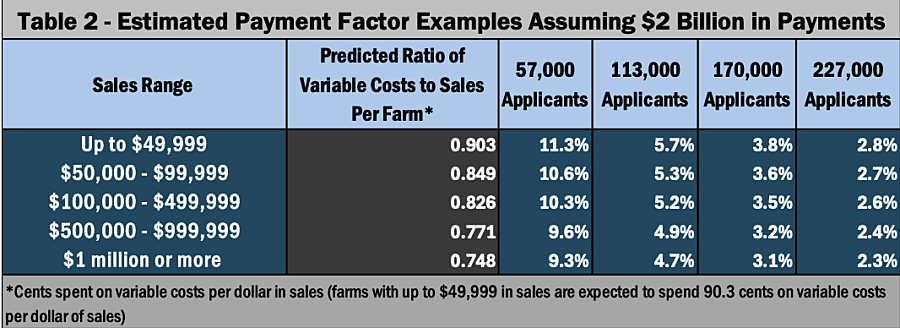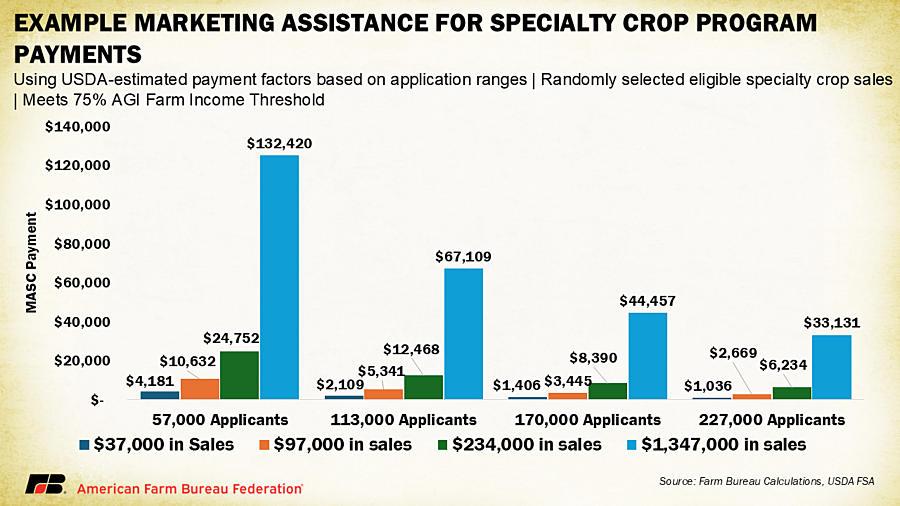Marketing Assistance for Specialty Crops: A Closer Look
TOPICS
Specialty Crops
Daniel Munch
Economist
Applications are now open for USDA’s new $2 billion Marketing Assistance for Specialty Crops (MASC) program. This initiative, administered by the Farm Service Agency (FSA), aims to help specialty crop producers manage heightened marketing costs and expand both current and new markets. However, the program’s structure does not require funds to be directed toward marketing-specific activities, functioning instead as general financial assistance for specialty crop farmers.
The announcement comes as specialty crop farmers continue to navigate economic challenges including elevated input and labor costs, volatile prices, growing global competition and uncertain regulatory and trade dynamics. Today, we explore the MASC program, including how it seeks to support growers and what farmers can expect as they navigate the application process.
**Update** As of January 6th, USDA announced several key changes to the MASC program: the application deadline has been extended from January 8th to January 10th, funding has been increased by $650 million, bringing the total allocation to $2.65 billion and the payment limit has been raised from $125,000 to $900,000.
The Unique Challenges of Specialty Crop Production
Specialty crops — including fruits, vegetables, tree nuts, nursery crops, and herbs — are a vital part of American agriculture. These crops not only provide nutritious food that families worldwide depend on for a balanced diet; through ornamental plants they also enrich living spaces and enhance the overall quality of life, making them integral to both health and well-being. According to the 2022 Census of Agriculture, over 239,000 specialty crop farms produced more than $115 billion in agriculture sales, supporting millions of jobs and generating billions more in downstream economic activity.
Despite their significance, the farmers who grow specialty crops face unique challenges that set them apart from other commodity producers. These crops are highly perishable and prone to damage, necessitating specialized equipment for harvesting, handling, storage and transportation. In many cases, the delicate nature of these crops requires significant manual labor, as automation options remain limited compared to other agricultural sectors. According to the most recent Agricultural Resource Management Survey, the average specialty crop farm spent over $142,000 on labor — an astounding 553% higher than the $22,000 labor expenditure reported by the average farm operation across all commodities. USDA data further highlights that labor alone accounts for nearly 45% of specialty crop operations’ variable costs, far exceeding the 9% average for other farming sectors. Additionally, specialty crop producers spend more on repairs and machine hire — 50% and 232% higher, respectively — due to the highly specialized equipment required to manage these high-value crops. On top of this, elevated prices and regulatory barriers for specialty fertilizer and pesticide products add to the financial burden. These cost dynamics, compounded by frequently burdensome state regulatory systems and fewer risk management options, often place U.S. specialty crop producers at a price disadvantage compared to their foreign-produced counterparts.
USDA intends for the MASC program to support specialty crop farmers in overcoming these challenges, with the added benefit of promoting domestic fruit and vegetable consumption. MASC is funded by the Commodity Credit Corporation, whose charter under Section 5(e) grants USDA broad authority to stabilize agricultural markets and incomes through financial assistance, marketing initiatives and other strategic interventions. While MASC is described as providing relief toward marketing expenses, the program does not police whether funds allocated to farmers are spent specifically on marketing activities, functioning instead as general financial support for specialty crop farmers.
Key Features of the Marketing Assistance for Specialty Crops Program
Eligibility
To participate in MASC, producers must:
- Be actively farming specialty crops for sale in 2025.
- Certify, through documentation, their sales for either 2023 or 2024 (or project 2025 sales if they are new producers).
- Complete and submit required documentation, including forms such as FSA-1140 and AD-1026.(Farmers applying for MASC must follow rules that protect highly erodible land and wetlands, which means they need to use “good farming practices” to qualify for the program.)
Eligible specialty crops include fruits, vegetables, tree nuts, nursery crops, honey, floriculture, hops, maple sap, tea, spices, herbs, Christmas trees, floriculture, turfgrass, mushrooms, vegetable seed and grass seed. Value-added products and non-specialty crops such as grains and forage are excluded.
Payments are capped at $125,000 per producer (increased to $900,000 as of January 6th), and if demand exceeds the original $2 billion allocation (now $2.65 billion following the January 6th update), payments may be prorated. Final payment factors will be determined after the application period closes.
Payment Calculations and Examples
MASC payments are based on the producer’s eligible sales from 2023 or 2024, or projected sales for 2025 for new producers. Eligible sales include only sales of commercially marketed raw specialty crops grown in the United States by the farmer. The portion of sales derived from adding value to a specialty crop, such as sorting, processing or packaging, is not included in a producer’s eligible sales. For example, the eligible sales for a farmer who grows cucumbers and sells raw cucumbers and pickles at a local market would be the sales of raw cucumbers sold at the market plus the raw value of the cucumbers used in the pickles - not the value of pickles sold. The raw value would also be the value of the crop at the packinghouse door – before it is processed and packaged for the grocery store. Total sales will also include crop insurance indemnities and payments from the Noninsured Crop Disaster Assistance Program (NAP).
USDA has provided the option to use marketing years 2023 or 2024 as the basis for 2025 sales calculations, offering farmers greater flexibility, particularly those who may have faced reduced sales due to natural disasters, pests or other unforeseen challenges.
MASC payments are calculated based on a tiered system that divides reported specialty crop sales into five sales ranges (Table 1). Each range has a corresponding payment factor, with smaller farms (those with lower sales) receiving larger payment percentages. This is intended to reflect the higher variable costs smaller farms face relative to their sales, as they lack the economies of scale that reduce costs for larger operations. Payment factors decrease progressively for higher sales ranges but are applied incrementally, similar to income tax brackets. For instance, an operation with $450,000 in sales would have the first $49,999 (from sales range one) multiplied by payment factor A, the next $50,000 (sales range two) multiplied by payment factor B and the remaining $350,001 (sales range three) multiplied by payment factor C to calculate the farmer’s MASC payment.
USDA will determine these payment factors after the application period closes, based on the total number of eligible applications and reported sales. If more producers apply, the payment factors will be adjusted downward to ensure the $2 billion funding cap is not exceeded (now $2.65 billion following the January 6th update). The USDA-provided estimated example payment factors by estimated numbers of applicants are presented in Table 2 below.
USDA imposes several payment limitations within the MASC program. Producers with an average adjusted gross income (AGI) exceeding $900,000 for the years 2021, 2022 and 2023 are not eligible for payments unless at least 75% of their AGI is derived from farming, ranching or forestry operations. Additionally, MASC payments are capped at $125,000 per person or legal entity (increased to $900,000 as of January 6th). Payments to legal entities are attributed to individual members based on their ownership shares, with reductions applied proportionally for members who are ineligible due to AGI limits or other criteria. Payments made to Indian tribes or tribal organizations are exempt from the payment cap. The following graph illustrates example MASC payments based on USDA's application estimations, using randomly selected specialty crop sales values. These calculations assume all producers meet the program's eligibility requirements, including the 75% AGI farm income threshold.
Special Cases
- New farmers must either provide a legally binding contract to sell a specialty crop in 2025 or show evidence that a specialty crop has been planted and is expected to be harvested and sold during the 2025 calendar year to qualify for MASC.
- Specialty crop sales intended for resale are only eligible if the crop undergoes a significant change in characteristics during the holding period (e.g., a 2-inch plant growing to 18 inches over four months).
- Producers who sell specialty crops through subscription or membership-based services, such as community-supported agriculture (CSA) programs, may include the portion of membership or subscription fees directly linked to specialty crops in their eligible sales.
How to Apply
Applications, including required forms and documentation, must be submitted within 31 days of the program's publication in the Federal Register (by Jan. 10). Eligible farmers should complete the following steps:
- Submit Form FSA-1140 (Marketing Assistance for Specialty Crops Application).
- Certify sales for 2023 or 2024, or projected 2025 sales with supporting documentation if they are new producers.
- Ensure all required forms, such as AD-2047 and CCC-902, are on file with FSA.
- Producers can contact their local FSA office for assistance or visit USDA’s MASC webpage for additional resources.
Conclusion
The MASC program aims to support specialty crop producers by partially mitigating marketing costs and fostering the expansion of domestic and new markets. The program provides payments based on reported or projected sales of raw, commercially marketed crops, with payment factors adjusted to prioritize smaller producers and reflect economies of scale. Applications, including required forms and documentation, may be submitted through Jan. 10, 2025 – 31 days after the Notice of Funds Availability was published in the Federal Register.
Specialty crops play a critical role in providing nutritious, fresh food and enhanced living environments for American consumers. Programs like MASC can help ensure these farmers, often facing elevated labor costs and other unique challenges, remain competitive and resilient in an increasingly challenging U.S. agricultural landscape.
Top Issues
VIEW ALL


